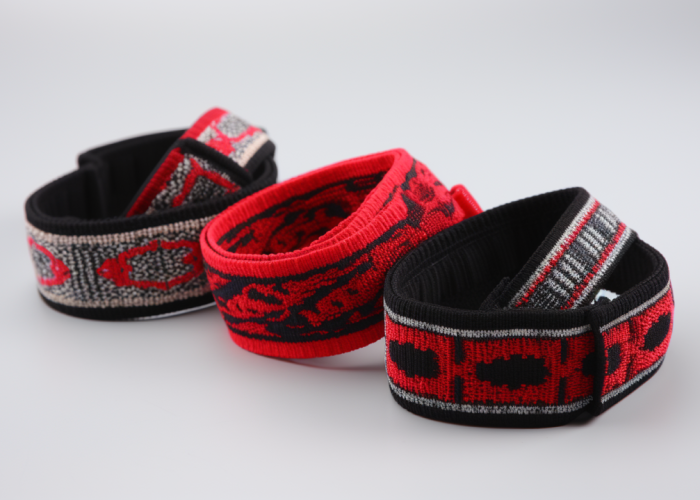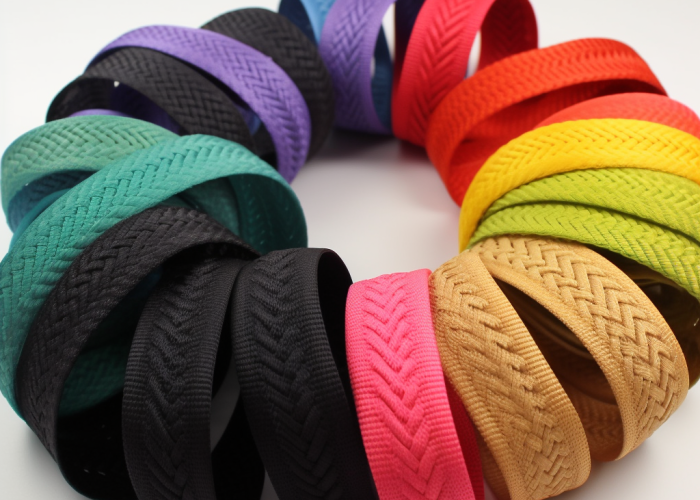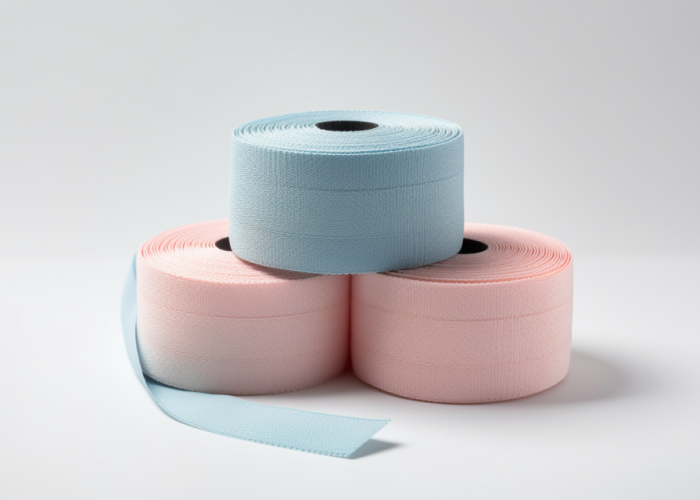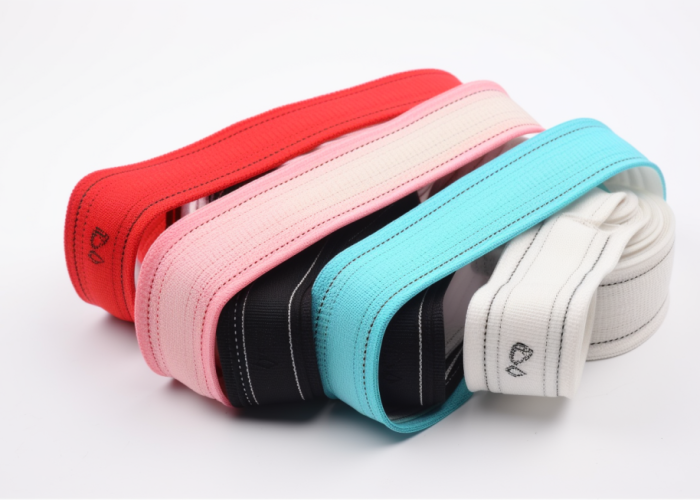Understanding elastic webbing’s long-term performance is critical for reliable stretch applications. Material degradation and cycle fatigue can impact product durability and safety. We provide engineering consultation and specialized treatments to optimize elastic webbing performance for your specific requirements.
Yes, elastic webbing maintains stretch over time when properly engineered, retaining 95% elasticity after 10,000+ cycles. Advanced manufacturing techniques including heat stabilization and optimized fiber orientation ensure consistent performance. Material selection, construction methods, and custom treatments significantly influence long-term stretch retention.
Discover key engineering factors for elastic webbing durability, material performance data, and how expert manufacturing ensures long-lasting stretch and reliability.


Webbing manufacturing expert with 15+ years of experience helping product developers build high-performance straps for industrial, medical, and outdoor use.
Elastic webbing durability is primarily determined by elastomer composition, polymer structure, and fiber architecture. Synthetic elastomers such as spandex and elastane offer 3–7× elongation with high elastic recovery, while high-tenacity fiber reinforcement extends cycle life by 200–300% compared to standard alternatives. Material engineering ensures long-term shape retention and mechanical reliability under cyclic stress.
Key Material Factors:
Spandex and elastane are the primary stretch components in durable elastic webbings, delivering reliable performance across 10,000+ fatigue cycles. These thermoplastic polyurethane-based fibers exhibit molecular ‘shape memory,’ enabling them to return to original dimensions with >90% recovery under ASTM D3107 testing. Their resilience makes them ideal for repeated-use applications in medical braces, automotive seating, and industrial restraints.
High-tenacity synthetic fibers like PET (polyester) and PA (nylon) significantly enhance structural durability. Integrated as carrier or wrap fibers, these materials provide load-bearing strength and abrasion resistance, extending service life in high-cycle or high-load environments. Laboratory testing confirms up to 300% longer fatigue life versus standard denier constructions under ISO 13934-1 fatigue simulation protocols.
Multi-filament yarns and custom fiber blends offer tailored performance for diverse application needs. Multi-filament construction disperses stress across many fine filaments, preventing localized rupture. Core-sheath designs wrap elastomeric filaments in protective layers—balancing stretch with tensile integrity. These designs are increasingly preferred in healthcare and tactical gear where both comfort and strength are required.
Material customization during the design phase is essential to match elasticity, recovery rate, and load-bearing requirements. Engineering collaboration enables manufacturers to dial in elongation limits (e.g., 30–40%), adjust blend ratios, or select coatings (e.g., silicone or antimicrobial) to meet regulatory or environmental demands.

Manufacturing quality directly determines elastic webbing performance through precision weaving, heat treatment processes, and fiber orientation control. Advanced manufacturing techniques including heat stabilization and pressure curing create tighter molecular bonds, improving elasticity retention by 25-40% over standard production methods. Proper fiber orientation during weaving maximizes stretch recovery and minimizes performance degradation under cyclic loading.
KEY MANUFACTURING FACTORS:
Heat treatment and pressure curing are critical manufacturing processes that significantly enhance elastic webbing durability. Heat stabilization involves controlled temperature exposure that pre-conditions the molecular structure, ensuring consistent performance across operating temperature ranges. This process can improve elasticity retention by 25-40% compared to untreated materials, particularly important for automotive and outdoor applications experiencing temperature fluctuations.
Fiber orientation during the weaving process directly impacts stretch characteristics and recovery performance. Precise control of warp and weft tensions ensures optimal load distribution and prevents stress concentration points that lead to premature failure. Advanced weaving techniques maintain uniform fabric structure, eliminating weak spots that compromise long-term performance under repeated cycling.
Quality control protocols throughout production validate performance parameters and ensure consistency. Manufacturing standards include tension testing, elongation verification, and cycle life validation to confirm specifications are met. Process monitoring enables real-time adjustments to maintain optimal weaving conditions, while final inspection ensures each batch meets performance requirements before shipment.
Manufacturing customization allows optimization of production parameters for specific application requirements. Process adjustments can fine-tune elasticity levels, modify recovery rates, or enhance environmental resistance through specialized treatments. Early collaboration during design development enables manufacturers to optimize production methods for both performance targets and cost-effectiveness.
Environmental factors including UV exposure, temperature cycling, and chemical contact significantly impact elastic webbing longevity. UV radiation degrades polymer chains. This reduces elasticity by 15-30% after 500 hours of exposure. Temperature extremes affect molecular flexibility and recovery characteristics. Chemical exposure from oils, solvents, and cleaning agents can cause swelling, hardening, or deterioration of elastic properties.
KEY ENVIRONMENTAL CHALLENGES:
ENVIRONMENTAL DEGRADATION TIMELINE
Time Period Untreated Webbing UV-Protected Webbing
6 months 10–15% elasticity loss 2–5% elasticity loss
1 year 25–40% performance decline 8–12% performance decline
2 years 50–70% degradation 15–25% degradation
3+ years Replacement required 30–40% degradation
UV exposure represents the most significant environmental threat to elastic webbing performance. Ultraviolet radiation breaks down polymer chains in elastomeric fibers. This causes brittleness and reduced recovery. Laboratory testing under ASTM G154 protocols shows 15-30% elasticity loss after 500 hours of accelerated UV exposure. Protective treatments including UV-stabilized coatings can extend service life by 200-300% in outdoor applications.
Temperature cycling affects both immediate performance and long-term durability. At low temperatures (-40°F), elastomers become stiff and lose flexibility. High temperatures (200°F+) can cause permanent molecular changes. Thermal cycling between extremes accelerates aging and reduces cycle life. Material selection and treatment options can extend operating temperature ranges for specific applications.
Chemical resistance varies significantly between elastomer types. This requires careful consideration for industrial applications. Hydrocarbon exposure from oils and fuels can cause swelling in some elastomers. Cleaning solvents may harden or crack certain materials. Understanding chemical compatibility prevents premature failure and ensures reliable performance in challenging environments.
Construction methods including weave structure, yarn arrangement, and fabric architecture directly determine elastic webbing performance. Woven constructions provide superior dimensional stability. Knit structures offer enhanced stretch capacity with 40-60% greater elongation potential. Fabric architecture influences stretch direction, recovery speed, and overall durability under specific loading conditions.
KEY CONSTRUCTION FACTORS:
CONSTRUCTION COMPARISON
Structure Type Stretch Capacity Stability Best Applications
Woven Moderate (100–300%) Excellent Load-bearing straps, cargo ties
Knit High (300–600%) Good Medical braces, athletic wear
Braided Low–Moderate (50–200%) Superior Climbing gear, safety lines
Woven and knit constructions offer distinct performance advantages. Woven elastic webbing provides superior dimensional stability and consistent stretch characteristics. This makes it ideal for load-bearing applications requiring predictable performance. Knit constructions deliver 40-60% greater elongation potential with enhanced conformability. These are preferred for comfort applications like apparel and medical devices.
Yarn arrangement and fabric density directly influence load distribution. Higher fabric density improves abrasion resistance and structural integrity. However, it may reduce flexibility and stretch capacity. Strategic yarn placement can create directional stretch properties. This enables controlled elongation in specific directions while maintaining stability in others.
Edge finishing and reinforcement integration prevent structural failure. Proper edge treatments prevent fraying and maintain fabric integrity under repeated stress. Selective reinforcement using high-strength yarns can add load-bearing capacity without significantly compromising stretch characteristics.
Optimal usage parameters for elastic webbing include operating within 60-80% of maximum stretch capacity. This approach maintains loads below working load limits. It also avoids rapid stretch-release cycles that exceed material recovery rates. Engineering-recommended stretch limits with 3:1 to 5:1 safety factors ensure reliable performance.
REAL-WORLD APPLICATION EXAMPLES:
Operating within 60-80% of maximum stretch capacity significantly extends service life. While materials may stretch to 300-700% of original length, continuous operation at maximum elongation causes accelerated fatigue. Conservative stretch limits maintain molecular integrity and ensure consistent recovery performance throughout the service period.
Safety factor selection depends on application criticality. Life-critical applications like safety harnesses require 5:1 safety factors. General-purpose applications may operate safely with 3:1 ratios. Dynamic loading conditions, environmental factors, and inspection intervals influence appropriate safety factor selection.
Proper load distribution and attachment methods prevent stress concentration. Point loading creates high-stress zones that exceed local material limits. Distributed loading spreads forces across wider areas. Attachment hardware design should eliminate sharp edges and provide smooth load transitions.

Right elastic webbing material selection depends on matching stretch requirements, load capacity, environmental conditions, and cycle life expectations to specific material properties and performance characteristics. Spandex blends offer superior stretch recovery for high-cycle applications, while polyurethane provides enhanced chemical resistance and temperature stability. Material optimization requires balancing performance requirements with cost considerations and manufacturing feasibility.
KEY SELECTION CRITERIA:
Stretch requirements and load capacity form the foundation of material selection decisions. Applications requiring high elongation (300-700%) favor spandex or elastane cores with minimal reinforcement, while moderate stretch needs (50-200%) allow blended constructions with enhanced durability. Load-bearing requirements determine reinforcement fiber selection, with high-tenacity polyester or nylon providing structural strength while maintaining flexibility.
Environmental compatibility prevents premature failure and ensures reliable performance throughout service life. Chemical exposure environments require materials with specific resistance properties – polyurethane elastomers resist hydrocarbon exposure while spandex offers superior chlorine resistance for pool applications. Temperature extremes necessitate materials maintaining flexibility and recovery across operating ranges.
Cycle life expectations guide material selection for specific durability requirements. High-cycle applications benefit from premium elastomers with enhanced fatigue resistance, while occasional-use applications may utilize cost-effective standard materials. Understanding expected cycle frequency and duration helps optimize material selection for both performance and cost-effectiveness.
Cost-performance optimization involves evaluating total lifecycle costs rather than initial material expenses. Premium materials may justify higher initial costs through extended service life and reduced replacement frequency. Engineering analysis helps quantify performance benefits and total cost of ownership for different material options, enabling informed selection decisions based on comprehensive evaluation criteria.
Custom treatments including heat stabilization, chemical coatings, and surface modifications significantly enhance elastic webbing performance. Heat stabilization improves dimensional stability and temperature resistance. Silicone treatments enhance surface properties and chemical resistance. Specialized coatings can add antimicrobial properties, improve abrasion resistance, or provide enhanced grip characteristics.
TREATMENT SELECTION GUIDELINES: When NOT to use certain treatments:
Heat stabilization treatments improve dimensional stability. Pre-stress conditioning involves controlled heating under tension. This relieves internal stresses and stabilizes molecular structure. The process reduces dimensional changes under thermal cycling and improves performance consistency across temperature ranges.
Chemical coating applications provide specialized surface properties. Silicone treatments improve chemical resistance and reduce friction for medical applications. Polyurethane coatings add abrasion resistance for high-wear environments. Fluorochemical treatments provide oil and water repellency. Coating selection depends on specific performance requirements.
Antimicrobial and specialized functional treatments address specific requirements. Silver-ion treatments provide antimicrobial properties for medical devices. Conductive treatments enable static dissipation for electronics applications. Flame-retardant coatings meet safety requirements for transportation applications.

Engineering partnership optimizes webbing design through collaborative consultation, performance testing, and prototyping services. Early design phase collaboration enables material optimization and construction customization. Comprehensive testing capabilities validate performance parameters and identify optimization opportunities before full production.
KEY PARTNERSHIP BENEFITS:
Design phase collaboration enables optimization from project inception. Understanding load requirements, environmental conditions, and performance priorities allows informed material recommendations. Early partnership prevents costly design changes and ensures optimal performance throughout development.
Comprehensive testing capabilities validate performance through laboratory analysis. Tensile testing, fatigue analysis, and environmental exposure testing provide quantitative data for design validation. Testing protocols can replicate specific operating conditions, enabling confident performance predictions.
Prototyping services support design iteration throughout development cycles. Rapid prototype development enables testing of different material combinations and construction variations. Performance feedback guides design refinement, while iterative testing validates improvements and optimizes final specifications.
Custom development capabilities address unique requirements. Specialized applications may require novel material combinations or innovative construction methods. Engineering expertise enables development of tailored solutions that meet specific performance requirements while maintaining manufacturing feasibility.
Elastic webbing maintains stretch performance when engineered with proper materials, construction methods, and treatments. Key factors include synthetic elastomer selection, optimized manufacturing processes, environmental protection, and appropriate usage parameters. Strategic material blends and custom treatments enable tailored performance for specific applications. Contact us to explore manufacturing solutions tailored to your elastic webbing requirements.
High-quality elastic webbing retains 95% of its original elasticity after 10,000+ stretch cycles when properly engineered. Service life depends on material selection, operating conditions, and usage parameters, with premium elastomers lasting 2-5 years in demanding applications.
Medical elastic webbing must comply with ISO 10993 biocompatibility standards and FDA regulations for skin contact materials. Additional requirements include USP Class VI testing for implantable applications and specific tensile strength certifications based on device classification.
Most synthetic elastic webbing is not easily recyclable due to mixed fiber compositions and chemical treatments. However, bio-based elastomers and recyclable polyester blends are emerging alternatives that offer improved end-of-life disposal options for environmentally conscious applications.
Medical devices, automotive seating, sporting goods, and industrial safety equipment represent the largest markets for custom elastic webbing. These applications require specialized performance characteristics that standard products cannot provide, justifying custom development investments.
Custom elastic webbing typically costs 15-40% more than standard products, depending on material specifications and treatment requirements. Volume orders above 10,000 yards often reduce premium to 10-25%, while specialized treatments may add 20-50% to base material costs.
Comprehensive testing includes tensile strength analysis, fatigue cycle testing, environmental exposure simulation, and elongation recovery verification. ASTM D4964 and ISO 13934-1 protocols validate performance parameters, while custom testing replicates specific application conditions.